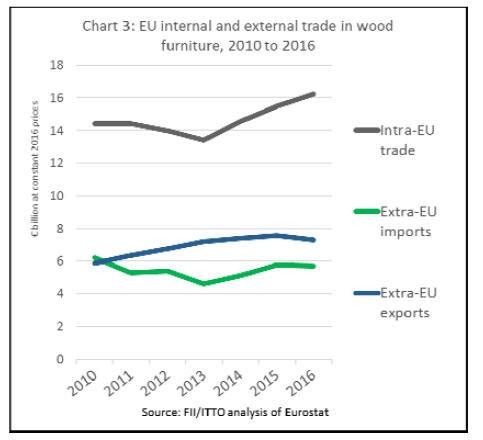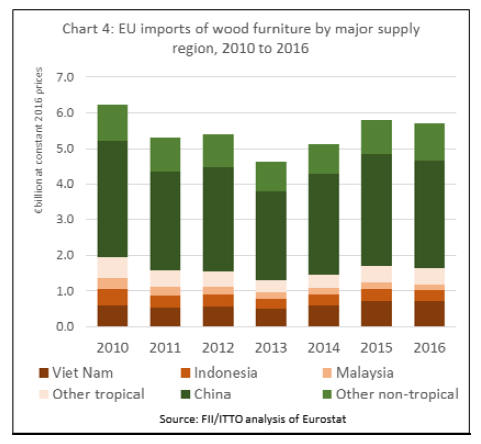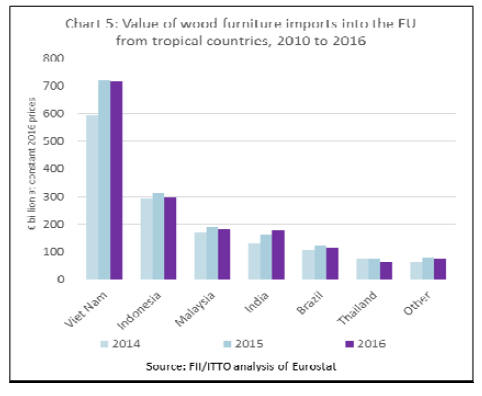|
Report from
Europe
Mounting competition in EU wooden furniture sector
Demand for wooden furniture in the EU is rising slowly
but the signs are not very positive for external suppliers
into the region, particularly from the tropics.
Although the official Eurostat annual production data has
yet to be published, a review of Eurostat indices and trade
data suggests that EU consumption of wooden furniture
was around Euro 36.1 billion in 2016, a gain of 1%
compared to 2015.
During 2016, consumption was quite stable in the largest
markets including Germany, the UK, Italy and France
compared to the previous year, but consumption increased
slightly in Spain, Poland, Sweden and the Netherlands
(Chart 1).

The value of EU wooden furniture production is estimated
to have been around Euro 39.6 billion in 2016, 1% higher
than the previous year, but still 20% down on the level
prevailing before the financial crises in 2008. A slight
slowdown in production in Italy and Germany, the two
largest manufacturing countries offset gains in Poland, the
UK, Spain, Romania and Lithuania. (Chart 2).

Analysis of Eurostat trade data reveals that internal EU
trade in wooden furniture was Euro 16.2 billion in 2016,
4% more than the previous year and continuing a rising
trend of the previous two years.
This trend is driven both by the slow rise in EU
consumption and by rising dependence of the internal EU
market on manufacturers located in lower cost member
states of Eastern Europe, particularly Poland, Romania,
and Lithuania.
The EU has maintained a trade surplus in wooden
furniture since 2011 when exports to non-EU countries
overtook imports from outside the EU. However, this
surplus has been narrowing, falling from Euro 2.59 billion
in 2013 to Euro 1.60 billion in 2016. In 2016, EU exports
to non-EU countries fell 4% to Euro 7.31 billion, while
imports from non-EU countries fell 1% to Euro 5.71
billion. (Chart 3).

Taken together these trends are indicative of intensifying
competition in the EU wooden furniture market. EU
manufacturers, particularly in Eastern Europe, are
producing more at a time when domestic consumption is
growing slowly and exports to other parts of the world are
weakening.
Last year EU wooden furniture exports declined into the
Middle East and Russia and were flat into North America,
Switzerland, Norway, and Japan. Minor gains in China
and a few other emerging markets were insufficient to
offset declining demand elsewhere.
After making significant gains in the EU market in 2015,
EU wood furniture imports from China and tropical
countries slipped back last year. In 2016, import value
declined 5% from China to Euro 3.01 billion and was
down 3% from tropical countries to Euro 1.63 billion.
However, EU import value from non-EU temperate
countries increased by 14% to Euro1.07 billion, with
particularly large gains by Turkey, Bosnia, Serbia,
Ukraine and Belarus (Chart 4).

EU wooden furniture imports from SE Asian suppliers
fell in 2016
The EU import value of wooden furniture declined from
most of the largest tropical suppliers in 2016. Import value
was down 2% from Vietnam to Euro 716 million, 6% from
Indonesia to Euro 299 million, 5% from Malaysia to Euro
183 million, 18% from Thailand to Euro 63 million and
3% from Brazil to Euro 118 million.
However, India bucked the trend and increased sales in the
EU by 10% in 2016, to Euro 179 million (Chart 5).

The total share of tropical countries in EU wooden
furniture import value remained level at between 28% and
29% in the last four years. However, during this time the
share of Vietnam increased at the expense of other South
East Asian countries, and also to some extent at the
expense of China, although the latter is still dominant.
Other temperate supplying countries outside the EU 每
including Turkey, Serbia, Ukraine and Belarus 每 have also
been increasing share at the expense of China and tropical
countries other than Vietnam.
Meanwhile, unlike in North America, the EU*s domestic
manufacturers are maintaining their domination of the
European wooden furniture market.
In 2016, domestic manufacturers accounted for around
87% for the total value of wooden furniture supplied into
the EU market, the same proportion as the previous year
and little changed, in fact, since 2007.
There are many reasons for the continuing dominance of
domestic manufacturers. An obvious short term factor is
weakening of European currencies in the last 2 years 每
particularly the UK pound - against the dollar and Chinese
yuan.
More enduring factors include: the relative high degree of
fragmentation in the European retailing sector 每 which
greatly complicates market access for overseas suppliers;
the underlying strength of European furniture
manufacturers and their brands in terms of innovation and
design; the obstacles to overseas suppliers complying with
European technical and environmental standards; and the
expansion of furniture manufacturing in Eastern Europe, a
location which combines ready access to raw materials
and to the internal EU market.
Although labour costs are quite high in Europe relative to
China and South East Asia, furniture manufacturers in the
EU are making a virtue of their shorter supply chains
which not only reduce transport costs but also allow
products to be delivered and, if necessary, returned more
rapidly.
Long-term implications of Brexit for EU wooden
furniture market
Looking to the future, the UK*s decision to withdraw from
the EU, an event scheduled to take place by 2019, has
particularly important implications for long-term growth
in EU demand for wooden furniture from tropical
countries, although the precise effects are still far from
clear.
The UK*s decision is particularly significant for the
wooden furniture trade because the UK is not only one of
the largest consuming markets in the EU, but is relatively
highly dependent on imports.
As much as 45% of all wooden furniture purchased in the
UK in 2016 was imported, more than in any other large
European consuming market including Italy (8%), Spain
(26%) and Germany (40%). A relatively high proportion
of the wooden furniture imported into the UK is from
countries outside the EU.
The UK accounted for more 34% of all wooden furniture,
and 40% of tropical wooden furniture, imported by the EU
from outside the region in 2016.
The immediate impact of the Brexit vote was to increase
the rate of depreciation of the British pound on foreign
exchange markets. The pound fell 15% against the US
dollar and 10% against the euro in the immediate
aftermath of the vote, and the value has remained at the
lower level ever since.
The effects of the Brexit vote and weak pound have taken
time to filter through into the British furniture market
place. The British Retail Consortium (BRC) reported no
discernible impact on retail spending and shop prices in
the second half of 2016.
However, the higher prices for imported goods combined
with uncertainty about long-term economic effects of
Brexit now appear to be discouraging consumer spending.
According to a study from Deloitte LLP, U.K. consumer
confidence weakened in the first quarter of 2017 and
households were the most pessimistic about their finances
in more than two years.
Longer-term, U.K. market prospects for wooden furniture
exporters in tropical countries will be significantly
impacted by the outcome of negotiations on the terms of
the withdrawal from the EU.
Brexit 每 soft or hard?
In the event of a so-called ※soft Brexit§ in which the U.K.
remains a part of the EU single market, there may not be a
significant change in the current trading environment.
However, this will require both parties to compromise on
what, at present, are polarised positions on difficult
political issues such as the size of the U.K.*s on-going
contribution to the EU budget and the free movement of
labour within the single market.
If there is a so-called ※hard Brexit§ in which the UK fails
to reach agreement with the rest of the EU and withdraws
or is ejected from the single market 每 an event which
could occur in 2019 每 there is very likely to be severe
economic fallout in the UK and, to some extent, other EU
countries.
Unlike the Brexit vote 每 which didn*t actually lead to any
change in the terms of the trading relationship 每 the U.K.*s
withdrawal from the single market would have immediate
and very profound effects.
It would impact on investment decisions, consumer
spending and confidence, and on immigration and the
level of access to, and the price of, labour. The UK*s preeminent
position in the EU in several large service sectors
- such as finance and pharmaceuticals 每 would come under
threat with far-reaching implications for the long-term
health of the national economy.
A ※hard Brexit§ would also lead to immediate imposition
of tariffs on goods from the EU that previously entered the
country tax free. There would be very profound economic
dislocation in those sectors that have progressed furthest to
integrate supply chains between the EU and UK, such as
car manufacturing, electrical goods and chemicals.
There would also be far-reaching effects on those sectors 每
such building materials and children*s toys 每 where
technical and safety standards have been harmonised
across the EU.
In these sectors, if the U.K. leaves the single market
without, at minimum, mutual recognition with EU
conformity assessment bodies, trade would be severely
curtailed until the required agreements are put in place.
Given the number and complexity of sectors involved, that
would take some time.
It should be said that the wooden furniture importing
sector in the UK is relatively less exposed to this form of
dislocation compared to other industries. EU import tariffs
are already zero on all wooden furniture with the
exception of components and kitchen furniture which are
subject to 2.7% tariff.
The furniture sector is also a so-called ※non-harmonised
sector§ in EU trade law. This means goods are not subject
to common EU rules and instead come under national
rules. The sector is regulated through the so-called
※mutual recognition principle§ which states that a Member
State must allow a product lawfully produced and
marketed in another Member State into its own market.
This is true even if the importing Member State*s local
rules impose more stringent (or different) requirements to
which the product does not conform.
The importing Member State can disregard this principle
only under strictly defined circumstances, such as where
public health, the environment or consumer safety are at
risk, and where the measures taken can be shown to be
proportionate.
In the U.K., there are national requirements for fire safety
in furniture which are mandatory for all products placed
on the market, irrespective of whether from the EU or
outside the EU. Imported furniture must be accompanied
by documented proof of compliance and with the required
permanent labels attached.
What this means in practice is that the U.K.*s withdrawal
from the single market may not significantly alter the
terms of trade for wooden furniture imported into the
country 每 since there is already a fairly level playing field
between U.K. imports from inside and outside the EU.
Nevertheless, the U.K.*s departure from the free market
would mean, at minimum, restrictions on the current free
movement of EU goods into the country. A customs
clearance process would be imposed for goods coming
into the UK from the EU, and vice versa. Each furniture
product would need a customer code and be subject to
scrutiny by customs at the border.
This adds a layer of trading complexity and increases the
potential for delayed shipments, a critical issue in the
furniture sector.
The large furniture retailers in the U.K. that already import
a lot of product from outside the EU are geared up for this
and may benefit from the U.K. leaving the single market.
In contrast, smaller U.K. retailers, and others that are
heavily dependent on imports from the EU, might be at a
competitive disadvantage. Large pan-European retailers
like Kingfisher and IKEA that operate a centralised
sourcing strategy and have gone a considerable way to
integrate their distribution networks and harmonise sales
activities across the continent would have to alter their
business model in the U.K.
IKEA, which currently sources the majority of its wooden
furniture from mainland Europe, is sufficiently concerned
about the prospect of the U.K. leaving the single market
that it recently announced its* intention to manufacture
more furniture in the U.K.
According to IKEA, this will help fend-off Brexit-led
price rises and competition from outside the EU. The
company has stated that it aims to double market share in
the UK irrespective of the outcome of Brexit negotiations.
Brexit 每 an opportunity for tropical country exporters
of wooden furniture
Overall, it seems that the U.K.*s departure from the EU
might provide some new opportunities for suppliers of
wooden furniture in tropical countries. However, it would
be wrong to overstate the potential.
A ※hard Brexit§, although a distinct possibility, is not
certain and there are powerful commercial voices on both
sides still lobbying hard for the U.K. to remain a part of
the single market.
Even if the U.K. leaves the EU single market, the U.K.
domestic furniture industry and large European
manufacturers like IKEA, are already developing
strategies to steer off what they perceive to be a renewed
challenge from competitors outside the EU.
If new opportunities are to emerge for tropical wooden
furniture suppliers in the U.K. post-Brexit, they will need
to work closely with the large retailing chains 每 both the
high-street stores and e-retailers 每 that already have global
supply chains and will be most willing to make savings
and offer lower prices by expanding procurement in
tropical countries.
There may also be opportunities at the lower-volume, high
end of the market for good quality designer products from
the tropics, if these can be shown to be supported by a
strong social and environmental narrative. However, that
requires significant investment in both design and
marketing.
|